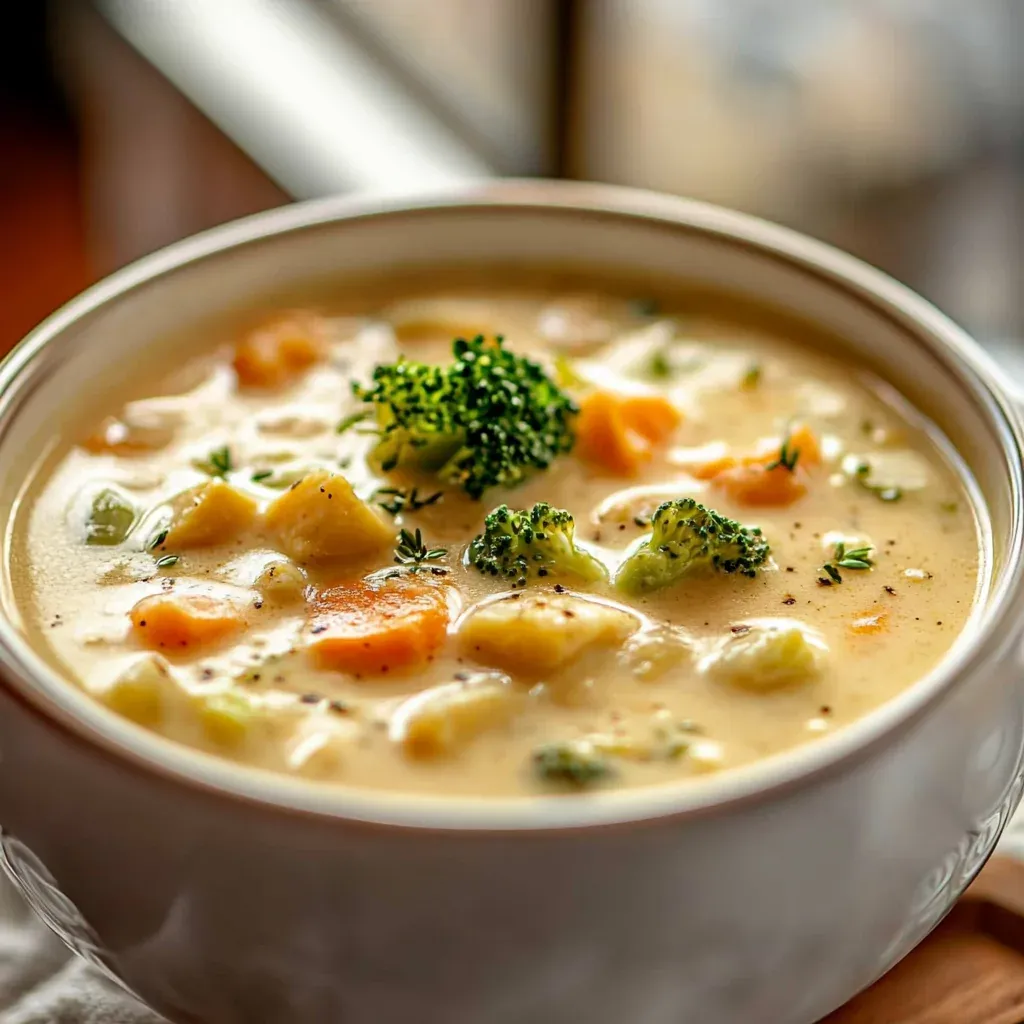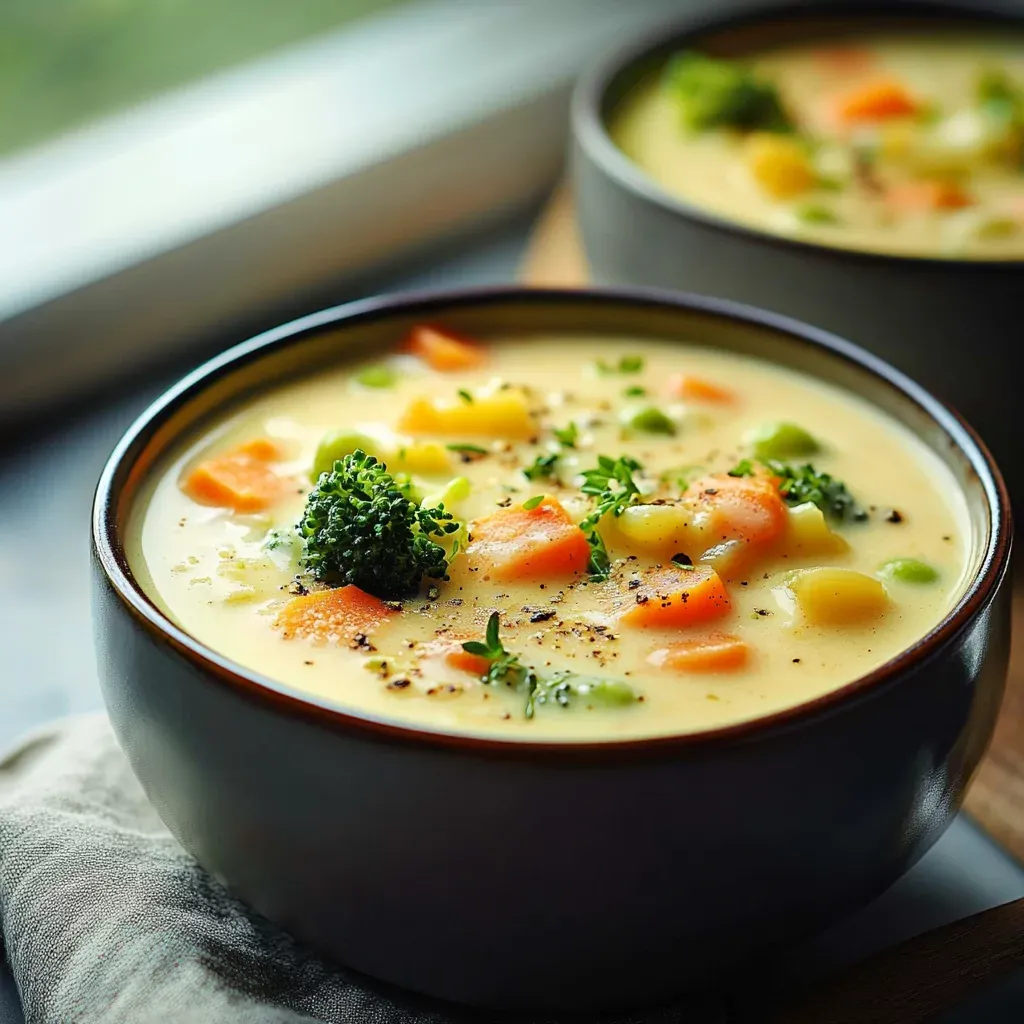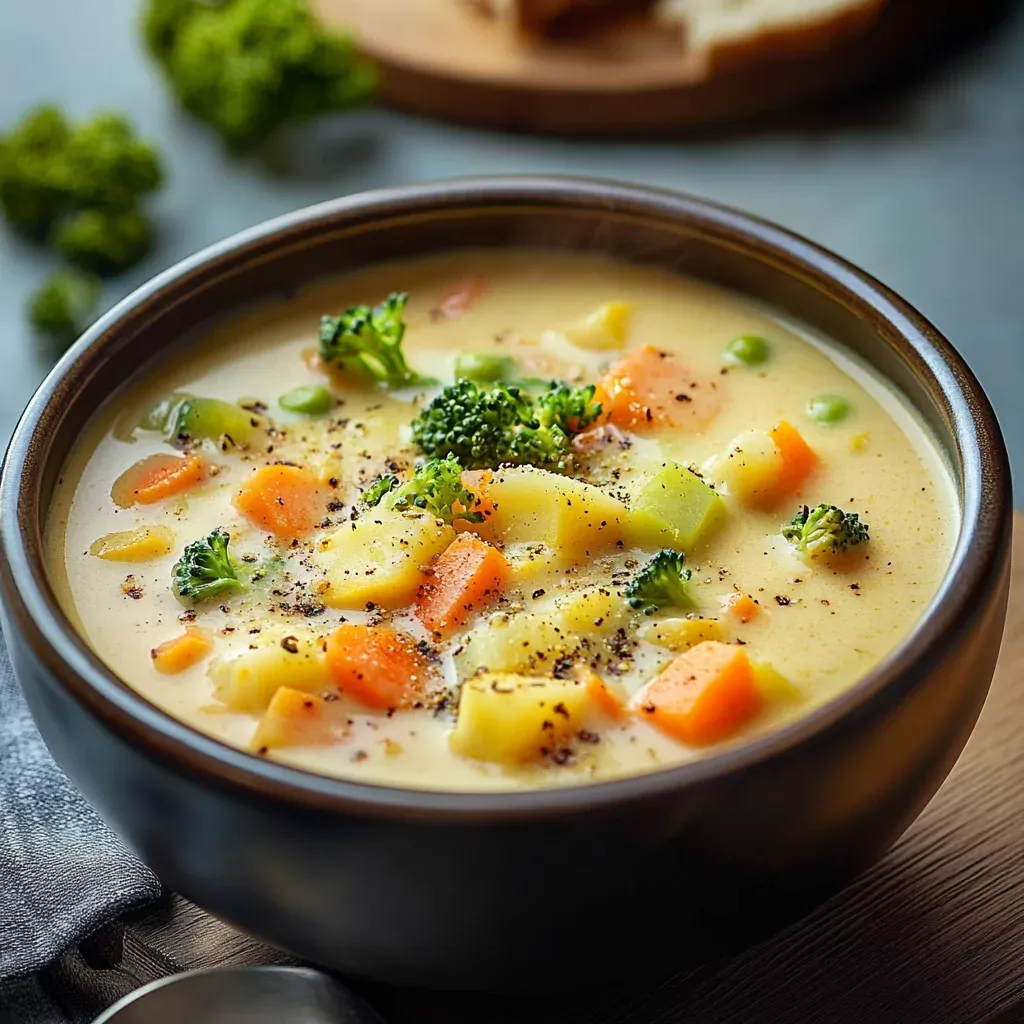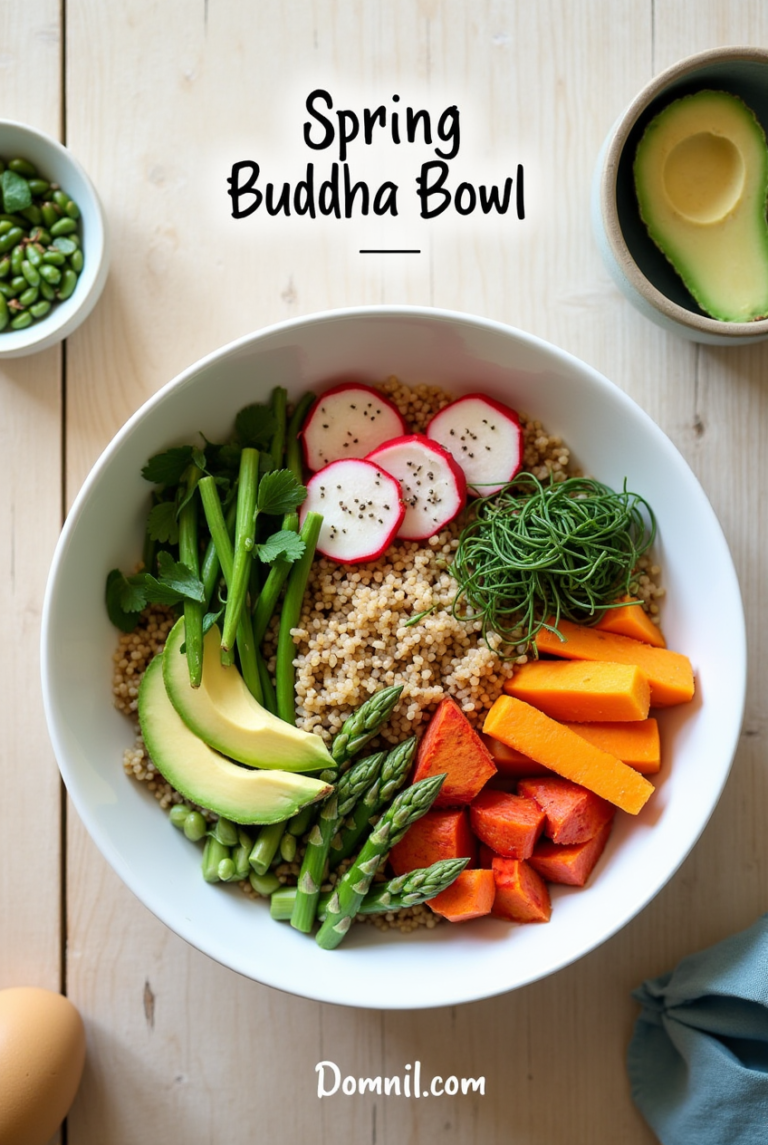Creamy Slow Cooker Vegetable Soup: A Comforting Classic
Introduction
There’s nothing quite like a warm bowl of creamy vegetable soup on a chilly day, and using a slow cooker makes the process effortless. The slow cooking method allows the flavors to meld beautifully, creating a rich, velvety soup that’s both nutritious and comforting. Whether you’re looking for a cozy meal for a weeknight dinner or something simple to meal-prep, this creamy slow cooker vegetable soup is a must-try.
Ingredients for a Creamy Slow Cooker Vegetable Soup

Essential Vegetables for the Soup
The heart of any vegetable soup lies in the selection of fresh, vibrant vegetables. Here’s a list of essentials to include:
- Carrots: Sweet and earthy, carrots add natural sweetness and color.
- Celery: Provides a subtle crunch and a savory base.
- Potatoes: Russet or Yukon Gold potatoes add thickness and creaminess.
- Onions: Essential for depth and flavor. Yellow onions work best.
- Garlic: Adds a robust, aromatic touch to the soup.
You can also include additional vegetables like zucchini, sweet potatoes, or bell peppers for extra flavor and variety.
Choosing the Right Broth
The choice of broth can significantly impact the flavor of your soup:
- Vegetable Broth: Ideal for keeping the soup vegetarian or vegan. Choose a low-sodium version for better control over seasoning.
- Chicken Broth: For non-vegetarians, chicken broth adds a richer, savory flavor.
Both options work well, but the key is to choose a high-quality, flavorful broth to enhance the soup’s base.
Creamy Base Ingredients
The creamy element takes this vegetable soup to the next level:
- Heavy Cream or Half-and-Half: For a rich, indulgent texture, heavy cream is ideal.
- Milk: For a lighter option, whole milk or even 2% milk works well.
- Non-Dairy Alternatives: Coconut milk adds a hint of sweetness, while cashew cream creates a velvety texture without altering the flavor.
These ingredients should be added towards the end of cooking to prevent curdling and ensure a smooth, creamy consistency.
Herbs and Seasonings
No soup is complete without the perfect blend of herbs and spices:
- Fresh Herbs: Thyme, parsley, and bay leaves add a fresh, aromatic quality.
- Dried Spices: A combination of salt, pepper, and paprika enhances the overall flavor.
- Optional Spices: A pinch of nutmeg or cayenne pepper can add warmth or spice.
Add fresh herbs at the end of cooking to preserve their bright flavor, while dried spices should be added at the beginning to infuse throughout the cooking process.
Preparing the Ingredients for Slow Cooking
Chopping and Dicing Vegetables Properly
To ensure even cooking, chop the vegetables uniformly.
- Carrots and Celery: Slice into ½-inch rounds for even cooking.
- Potatoes: Dice into 1-inch cubes for a hearty texture without becoming mushy.
- Onions and Garlic: Mince finely to ensure they blend seamlessly into the broth.
Consistency in chopping ensures that all vegetables cook at the same rate, giving the soup a perfect texture.
Sautéing Aromatics for Enhanced Flavor
For an added layer of flavor, consider sautéing your onions and garlic before adding them to the slow cooker.
- Sauté in Olive Oil or Butter: Cook the onions and garlic until they are translucent and fragrant, about 3-5 minutes.
- Optional Step: Sauté carrots and celery for a caramelized flavor.
This step isn’t required but will enhance the soup’s depth and complexity.
Adding Protein Options (Optional)
For those looking to make the soup more filling, consider adding a protein source:
- Legumes: Add lentils, chickpeas, or white beans for extra protein and fiber.
- Tofu or Tempeh: For a plant-based protein boost, add cubed tofu or tempeh.
- Chicken or Turkey: If not vegetarian, shredded chicken or ground turkey can make it heartier.
Ensure proteins like beans or lentils are cooked beforehand unless the slow cooker will run for the full 8 hours.
The Slow Cooking Process
Setting the Slow Cooker Temperature
Choosing the correct temperature is crucial for the perfect slow-cooked soup:
- Low Setting: Cook on low for 6-8 hours to allow flavors to develop fully.
- High Setting: Cook on high for 4-6 hours if you’re short on time.
For the most flavor, the low setting is recommended.
Layering Ingredients in the Slow Cooker
Layering helps ensure the vegetables cook evenly:
- Base Layer: Add potatoes, carrots, and celery to the bottom of the slow cooker.
- Middle Layer: Place onions and garlic on top of the harder vegetables.
- Top Layer: Pour in the broth and seasonings, ensuring everything is submerged.
Avoid stirring until after the initial cooking period to maintain the integrity of the layers.
Cooking Time Guidelines
Once all ingredients are added, set the timer and let the slow cooker do the work:
- High Setting: 4-6 hours.
- Low Setting: 6-8 hours.
After cooking, check the tenderness of the vegetables and ensure they are fork-tender before proceeding to the next step of blending.
Making the Soup Creamy
A creamy vegetable soup is all about achieving the perfect silky texture. Here’s how to do it.
Blending Part of the Soup for Thickness
To create a creamy consistency without adding too much dairy, blend a portion of the soup:
- Immersion Blender: Use an immersion blender directly in the slow cooker to blend about half of the soup, leaving some chunks for texture.
- Standard Blender: Carefully transfer a few cups of the soup to a standard blender, blend until smooth, and return it to the slow cooker.
Blending part of the soup thickens it naturally, giving it a velvety consistency while still retaining some heartiness.
Adding Dairy or Dairy-Free Alternatives
Once the soup is blended, it’s time to add the creamy component:
- Heavy Cream or Half-and-Half: Stir in ½ to 1 cup of heavy cream or half-and-half for a rich, luxurious finish.
- Milk: For a lighter option, add 1 cup of whole milk.
- Non-Dairy Options: Use coconut milk, almond milk, or cashew cream to keep it dairy-free.
Add the cream or milk in the last 30 minutes of cooking and stir well to prevent curdling.
Balancing Flavors for the Perfect Creaminess
Once the cream has been added, taste the soup and adjust the flavors:
- Salt and Pepper: Add additional salt and pepper as needed.
- Herbs: Stir in fresh herbs like parsley or thyme for brightness.
- Acidity: A splash of lemon juice or apple cider vinegar can brighten the flavors and balance the richness.
These finishing touches ensure the soup is well-rounded and flavorful.
Variations and Customizations
This slow cooker vegetable soup is highly versatile. Here are some ways to customize it to suit your taste.
Adding Grains for a Hearty Soup
Grains can make the soup more filling and nutritious:
- Rice: Add ½ cup of uncooked rice in the last 2 hours of cooking.
- Quinoa: Stir in cooked quinoa just before serving for a protein boost.
- Barley: Add ½ cup of barley at the start for a chewy texture.
Grains will absorb some of the broth, so you may need to add extra liquid if you go this route.
Spicy Vegetable Soup Variations
If you enjoy a little heat, try adding spice to your soup:
- Cayenne Pepper: Add a pinch for subtle heat.
- Red Pepper Flakes: Sprinkle in for a bold, spicy kick.
- Paprika or Smoked Paprika: Adds both spice and depth of flavor.
These additions will give the soup a warming, zesty undertone.
Vegan and Gluten-Free Modifications
To make this soup vegan or gluten-free, follow these simple modifications:
- Vegan: Use vegetable broth and non-dairy milk like coconut or cashew milk.
- Gluten-Free: Ensure the broth is gluten-free, and skip any thickening agents containing gluten.
These modifications keep the soup inclusive for various dietary preferences.
Tips for the Best Slow Cooker Vegetable Soup
To ensure your soup turns out perfect every time, consider these helpful tips.
Avoiding Overcooked Vegetables
Overcooking can cause vegetables to become mushy. Follow these guidelines:
- Delicate Vegetables: Add vegetables like zucchini or spinach in the last hour of cooking to avoid over-softening.
- Monitor Cooking Time: Check the soup at the 6-hour mark (on low) to ensure the vegetables are cooked but not overdone.
This prevents the soup from becoming too thick or mushy.
Enhancing Flavor with Fresh Herbs at the End
Fresh herbs can elevate the flavor of your soup. Add them at the right time:
- Parsley or Cilantro: Stir in a handful of chopped herbs just before serving.
- Thyme or Basil: Add during the last 15 minutes for a fragrant finish.
Adding herbs at the end preserves their vibrant flavor and color.
Storing and Reheating Leftovers
Creamy soups store and reheat well, making them perfect for meal prep:
- Refrigeration: Store in an airtight container in the fridge for up to 4 days.
- Freezing: Freeze in individual portions for up to 3 months. Thaw overnight in the fridge before reheating.
- Reheating: Warm over low heat on the stovetop or in the microwave, stirring occasionally to maintain creaminess.
Proper storage ensures your soup stays delicious even after a few days.
Serving Suggestions and Pairings
Best Bread and Crackers to Serve with the Soup
Pair your creamy vegetable soup with the perfect bread or crackers for a satisfying meal:
- Rustic Bread: A crusty loaf of sourdough or French bread is ideal for dipping.
- Garlic Bread: Adds a flavorful, crispy element to the meal.
- Gluten-Free Crackers: Perfect for those avoiding gluten but still wanting a crunchy side.
These pairings complement the rich, creamy texture of the soup beautifully.
Adding Toppings for Extra Flavor
Elevate your soup with some tasty toppings:
- Croutons: Add a crunchy contrast with seasoned croutons.
- Grated Cheese: Sprinkle Parmesan or cheddar for extra richness.
- Fresh Herbs: Garnish with parsley or chives for a pop of freshness.
These toppings add texture and enhance the overall flavor of the soup.
Frequently Asked Questions About Slow Cooker Vegetable Soup
Here are answers to some common questions about making creamy slow cooker vegetable soup.
1. Can I Use Frozen Vegetables?
Yes, you can use frozen vegetables, and they work wonderfully in this soup. However, keep a few things in mind:
- Add Later: To prevent overcooking, add frozen vegetables in the last 1-2 hours of cooking on low or 30 minutes on high.
- No Need to Thaw: Frozen vegetables can go straight into the slow cooker without thawing.
- Texture Consideration: Frozen vegetables may soften faster than fresh, so monitor the cooking time carefully.
Using frozen vegetables is a great way to save time while still achieving a delicious, hearty soup.
2. How Do I Make the Soup Thicker Without Cream?
If you want to thicken the soup without adding cream, try these methods:
- Blend More Vegetables: Blend a larger portion of the soup to achieve a thicker consistency.
- Add a Slurry: Mix 1 tablespoon of cornstarch or flour with 2 tablespoons of water, then stir it into the soup during the last 30 minutes.
- Use Potatoes: Potatoes naturally thicken the soup as they cook, so adding an extra potato or mashing some can help.
These methods will create a thick, velvety texture without relying on dairy.
3. Can I Cook It Overnight?
Yes, cooking the soup overnight on a low setting is an excellent option, especially if you want a hot meal ready in the morning:
- Set to Low: Cook on the low setting for 8 hours to ensure the vegetables don’t overcook.
- Use a Timer: If your slow cooker has a timer, set it to switch to the “keep warm” mode after the cooking time is done.
- Safety Tip: Ensure there’s enough liquid to prevent the soup from drying out overnight.
Cooking overnight allows the flavors to develop fully, resulting in a richer, more robust soup.
4. How Do I Adjust the Recipe for a Pressure Cooker or Instant Pot?
To make this recipe in a pressure cooker or Instant Pot, follow these adjustments:
- Sauté First: Use the sauté function to cook onions, garlic, and aromatics before adding other ingredients.
- Cooking Time: Cook on high pressure for 8-10 minutes, then do a quick release.
- Blending: Use an immersion blender or remove some soup to blend after pressure cooking.
- Add Cream After Cooking: Stir in the cream or dairy-free alternatives after releasing the pressure.
This method significantly reduces the cooking time while delivering the same creamy results.
5. What’s the Best Way to Reheat Creamy Soup?
Reheating creamy soup requires gentle heat to maintain its texture and prevent curdling:
- Stovetop: Heat over low to medium heat, stirring frequently until warmed through. Avoid boiling.
- Microwave: Reheat in 30-second intervals, stirring in between to ensure even heating.
- Add Liquid if Needed: If the soup thickens too much in the fridge, add a splash of broth or milk to loosen it while reheating.
These tips will help keep the soup smooth and delicious even after storing it.

Conclusion
Creamy slow cooker vegetable soup is the perfect comfort food for any season. With its rich, velvety texture and blend of hearty vegetables, it offers warmth and nourishment in every bite. The slow cooker makes the process incredibly easy, allowing the flavors to develop over hours while you go about your day. Whether you’re following the classic recipe or customizing it with your favorite ingredients, this soup is guaranteed to be a hit.
Pair it with crusty bread, top it with fresh herbs, or enjoy it as a standalone meal—it’s versatile, nutritious, and incredibly satisfying. So, dust off your slow cooker, gather your vegetables, and get ready to enjoy the ultimate bowl of creamy, homemade goodness.
FAQs
1. Can I freeze this soup with dairy added?
Yes, but for best results, freeze the soup before adding cream or milk. When reheating, add the cream after thawing to maintain the smooth texture.
2. What are the best vegetables to add for extra flavor?
Root vegetables like parsnips, sweet potatoes, or leeks add a depth of flavor. Spinach or kale can also be added near the end for extra nutrients.
3. How can I make the soup taste richer?
Adding a splash of white wine, a sprinkle of Parmesan, or using roasted garlic instead of raw can enhance the richness of the soup.
4. Can I substitute water for broth?
While water can be used, it’s recommended to add extra seasoning or bouillon to compensate for the lack of broth flavor.
5. How do I keep vegetables from becoming too soft in the slow cooker?
Add heartier vegetables like carrots and potatoes early, but wait to add delicate vegetables like zucchini or spinach until the last hour of cooking.







